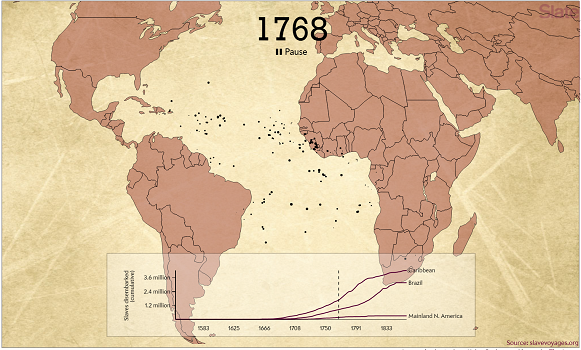CHY4U
World History Since the Fifteenth Century
Unit 2: 1650 - 1789: What's Worth Fighting For?
Activity 2: Slavery and Resistance

Click on the map above. On the page that loads, the interactive map shows the history of the Atlantic slave trade, which lasted from middle of the 15th century to the end of the 19th century.
What questions occur to you as you watch the animation? Certainly, there are many questions this animation raises but some you might consider are:
- Why is there a steady increase in the slave trade starting in 1666?
- Why are the time intervals inconsistent?
- Why do the origins of the dots move further south as time progresses?
- How does the inclusion of modern political borders impact my understanding of this map?
 Questions on the Atlantic Slave Trade
Questions on the Atlantic Slave Trade
Think of one question about the Atlantic slave trade that is NOT googleable (e.g. not factual only). Use the Questioning Grid below to help you create your questions.

The Transatlantic Slave Trade
The Transatlantic Slave Trade was motivated by the desire for cheap labour in the Americas. Several European powers, primarily Spain and Portugal, attempted to use the Indigenous people of the Americas as a labour force, but they encountered several problems. The same European diseases that had decimated Mesoamerica impacted potential Indigenous workers, limiting their ability to survive forced labour. Enslaved Africans, however, had already been exposed to the same illnesses as the Europeans, meaning they were much less likely to succumb to them. It was also more difficult for slavers to confine enslaved Indigenous peoples; because the Indigenous people were familiar with the region, they could more easily escape European masters by heading deeper into the continent.
Finally, key figures like Bartolomé de las Casas argued that the Indigenous people should be converted, not enslaved. This argument was applied to Africans with much less frequency, meaning that there were far fewer moral objections to their enslavement.
Several internal factors determined European slavers’ access to potential slaves in Africa. As you learned in an earlier activity, the inconsistent use of hard currency in West Africa meant that slaves were the only pan-regional currency; thus, even those European traders who were not primarily slavers kept slaves on hand for trade. However, the greatest growth in the slave trade came from war. Enslaving prisoners of war was a common practice in Africa; it also provided European slavers with easy access to numerous slaves. The influx of European technologies like guns and gunpowder intensified the conflicts between communities, thus providing slavers with even more potential slaves.
How much impact did war have on the trade? In an interview with BBC History, Doctor Akosua Adoma Perbi, the head of the history department at Ghana's Legon university, explains that “One traveller wrote in his memoirs that in 1681 he had got only eight slaves after combing the whole of Ghana's coast from west to east. But when he asked why that was, he was told the people were at peace.” (BBC News, March 29, 2007)
What Were They Thinking?
At first, it can be challenging to understand why the oppressed might be complicit in their own oppression. This, of course, is why Historical Perspective is so important. For example, you have already learned that Western African communities were not unified. Like their European counterparts, they were often engaged in conflicts that made cooperation highly unlikely. For Europeans and Africans, allegiances with leaders from the other continents were sometimes more likely than an allegiance with neighbouring powers.
The two primary sources below might help you understand the perspective of West Africans. The first explains some of the fears enslaved Africans had about European slavery. The second provides insight into the political maneuvering necessary for African rulers to maintain control of their possessions.
 Slavery Primary Sources - Say Something
Slavery Primary Sources - Say Something
After you have examined the two sources below, complete a “Say Something” reflection about your thinking on these sources using the following framework:
- highlight a key idea or point or
- ask a question or
- clarify something you misunderstood or
- make a comment or observation or
- make a personal connection
Adapted from Kylene Beers, When Kids Can't Read, What Teachers Can Do and Bruce Wellman and Laura Lipton, Data-Driven Dialogue: A Facilitator's Guide to Collaborative Inquiry.
“There is a big difference between the slaves of the Portuguese and those of the negroes [Africans]. The first do not only obey words, but even signs. They are especially afraid of being taken to Brazil or to New Spain, because they are convinced that when they arrive at those lands, they will be killed by the buyers, who, as they think, will make gunpowder of their bones and extract of their brains and flesh the oil that is sold in Ethiopia [….]. The reason they invoke is that they sometimes find hair in the leather bottles, which in their opinion comes from humans skinned for that purpose. Therefore, out of fear of being sent to America, they get frantic and try to run away to the forest. Others, at the moment of embarking, challenge the blows and kill themselves, jumping into the water (Cavazzi 1956 [1687]: I. 160).”
This is an excerpt from a letter sent by Queen Njinga, a ruler of an African kingdom to a representative of the Portuguese.
“With all my heart I appreciate that Your Honour will come to this fort [...], allowing me to give to you, as to a father, an account of how, when I sent some pieces [objects for trade] to the market [...], Aire [name of rival to the queen] launched an attack and stole some thirty pieces from me. When I gave orders to demand satisfaction from him as my vassal, my warriors found themselves face to face with nine men who were with Tigre [Estêvão de Seixas Tigre, name of a Portuguese soldier] in my territory, and when he pushed these nine men against my troops outside [...], they were, God willing, defeated by my warriors. The surviving six of them were delivered to me. It made me sad to learn that in Aire’s rocks, there are Portuguese soldiers supporting Aire. I received them warmly because they are vassals of the king of Spain, to whom I owe obedience as the Christian I am (Sousa 1985: 244-245).”
Person under someone else’s authority.
Resistance in the Americas
While enslaved people could not bring possessions with them to the Americas, they did bring traditions and practices that would become part of western culture. For example, the African drumming traditions, brought to America by Africans, provided the backbone for virtually all forms of modern music with a beat, such as jazz, rock, and hip hop. In the late 1600s and 1700s, however, these drums were viewed with deep suspicion by slaveowners. Because the drums were used to communicate at a distance, plantation owners feared that the drums were being used to plan revolts against their owners. Thus, laws were passed throughout the colonies to ban the drum:
It is absolutely necessary to the safety of this Province, that all due care be taken to restrain Negroes from using or keeping of drums, which may call together or give sign or notice to one another of their wicked designs and purposes.
While the intent of the drumming is unclear, the perspective of slave owners was not. Clearly, slaveowners feared that the drums were being use to orchestrate violent uprisings. However, in the TED talk below, historian Chris Johnson suggests that the slave’s rebelliousness was far more subtle.
 Reflection
Reflection
How does this argument contribute to your understanding of how the meaning of “fighting for” in the unit question - What is worth fighting for?
You can reflect in your Portfolio on any of the unit questions or the course question at any time, or you may wish to use another method to collect your personal reflections, such as a document (word or google), journal entry, blog post, etc.
The Slave Trade and Britain
"Every brick in your infernal town is cemented with an African’s blood."
The quotation above is attributed to a drunken 18th century actor who uttered this response to a crowd who booed him off the stage in Liverpool. It is illuminating because it suggests not only the extent to which Britain relied on the slave trade, but also that the public was well aware of the dependency.
The timeline below provides a detailed overview of the slave trade. While you are encouraged to explore the entire timeline to enhance your learning, you are only required to focus on two trails: How the Slave Trade Worked and Resistance and Abolition.
 Your What is Worth Fighting for? Questions
Your What is Worth Fighting for? Questions
What questions do you have about slavery and resistance? Save 1 or 2 inquiry questions to your Portfolio.